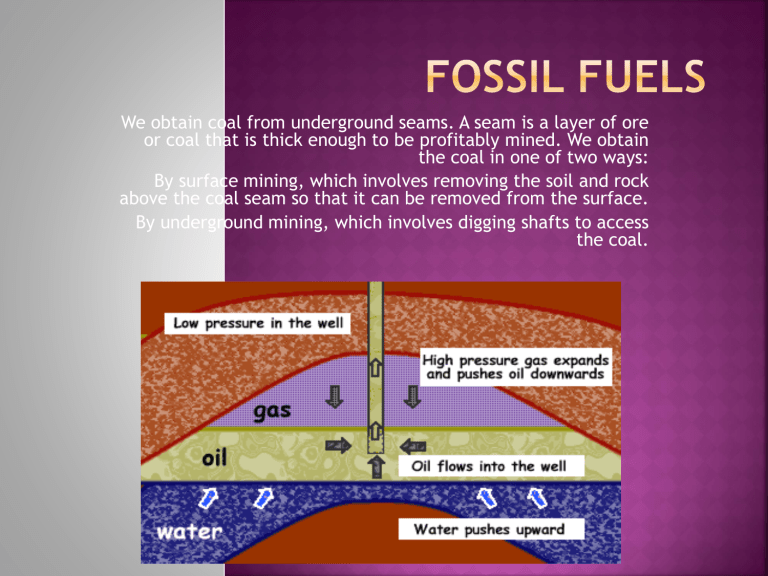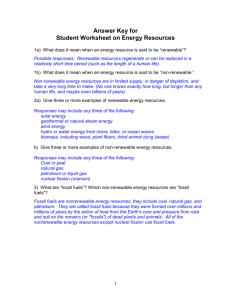Fossil Fuels - TECHSHARKTANK20

We obtain coal from underground seams. A seam is a layer of ore or coal that is thick enough to be profitably mined. We obtain the coal in one of two ways:
By surface mining, which involves removing the soil and rock above the coal seam so that it can be removed from the surface.
By underground mining, which involves digging shafts to access the coal.
Global Warming: higher temperatures that leads to further temperature rises. For example, snow and ice, being white, tend to reflect a high proportion of incoming sunlight, reducing the heat absorbed from the sunshine. As sea ice melts, it is replaced by dark water that tends to absorb the incoming sunlight and to be warmed as a result.
Forest Fires : Due either to drying out of tropical forests or to forests being destroyed by bark beetles, which used to be killed off over the winter. Forest fires release the carbon dioxide sequestered in the trees.
Renewable energy is energy which comes from natural resources such as sunlight, wind, rain, tides, and geothermal heat, which are renewable (naturally replenished).
Wind power is the conversion of wind energy into a useful form of energy, such as using: wind turbines to make electricity, windmills for mechanical power, wind pumps for water pumping or drainage, or sails to propel ships.
Geothermal energy is thermal energy generated and stored in the Earth. Thermal energy is the energy that determines the temperature of matter. Earth's geothermal energy originates from the original formation of the planet and from radioactive decay of minerals. The geothermal gradient, which is the difference in temperature between the core of the planet and its surface, drives a continuous conduction of thermal energy in the form of heat from the core to the surface.
Coal is a hard, black colored rock-like substance. It is made up of carbon, hydrogen, oxygen, nitrogen and varying amounts of sulphur. There are three main types of coal – anthracite, bituminous and lignite. Anthracite coal is the hardest and has more carbon, which gives it a higher energy content. Lignite is the softest and is low in carbon but high in hydrogen and oxygen content.
Oil is another fossil fuel.
It was also formed more than 300 million years ago. Some scientists say that tiny diatoms are the source of oil. Diatoms are sea creatures the size of a pin head. They do one thing just like plants; they can convert sunlight directly into stored energy.
Alternative energy sources are renewable and are thought to be "free" energy sources. They all have lower carbon emissions, compared to conventional energy sources. Everyday, the world produces carbon dioxide that is released to the earth’s atmosphere.
Energy is used for heating, cooking, transportation and manufacturing.
Energy can be generally classified as non-renewable and renewable. Over
85% of the energy used in the world is from non-renewable supplies.
Most developed nations are dependent on non-renewable energy sources such as fossil fuels (coal and oil) and nuclear power. These sources are called non-renewable because they cannot be renewed or regenerated quickly enough to keep pace with their use. Some sources of energy are renewable or potentially renewable.
Coal is the most abundant fossil fuel in the world with an estimated reserve of one trillion metric tons.
Natural gas is usually not contaminated with sulfur and is therefore the cleanest burning fossil fuel. The use of natural gas is growing rapidly. Besides being a clean burning fuel source, natural gas is easy and inexpensive to transport once pipelines are in place.
In most electric power plants, water is heated and converted into steam, which drives a turbinegenerator to produce electricity. Fossil-fueled power plants produce heat by burning coal, oil, or natural gas. In a nuclear
power plant, the fission of
uranium atoms in the reactor provides the heat to produce steam for generating electricity







